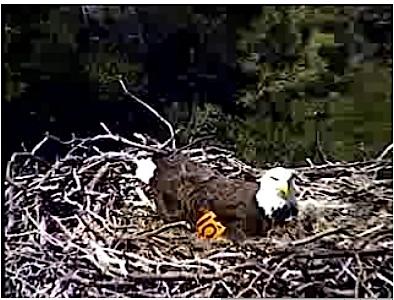Forgive the staff at Channel Islands National Park if they popped open some champagne this past weekend. It turns out that a pair of bald eagles on Santa Cruz Island are the parents of two eaglets.
The parents, K-10 and K-26, started to welcome their brood into the world on Saturday, when the first hatched about 7:30 a.m. The second showed up Monday morning not too long before noon. This same pair of eagles made history in 2006 when they became the first bald eagles to successfully reproduce on the California Channel Islands in nearly 50 years.
But K-10 and K-26 still have a job to do. The female, K-26, will stay in the nest almost constantly to ensure the safety of her downy children, who are partially blind and largely helpless, park biologists say. For his part, K-10 will make excursions to find food to bring back to the Pelican Harbor nest for his growing family, they add.
The eaglets will grow rapidly, but it will be a couple months before it’s ready to take to the air on its own. Those eager for eaglet views can continue to follow mating season with the bald eagle cam. You can also catch the eaglet’s coming-out party online at the eagle discussion board.


 Support Essential Coverage of Essential Places
Support Essential Coverage of Essential Places







Comments
THIS IS SO COOL! I clicked on the live webcam and after only 2 minutes K-10 began feeding them from a carcass in the nest. I got to watch for *10 minutes and then he sat on them again and did some "nest-keeping"!
At the time I was looking at this, it almost looked like there's a bird besides K-10 in the nest but it's not moving around. I hope that's not K-26 but rather another meal waiting for later.
(I tried leaving this comment yesterday afternoon but I was unable to.)
I have been visiting every day and have thoroughly enjoyed observing them! In fact it was a bird carcass in the nest because the next day, K-26 was plucking its feathers and feeding it to her eaglets. I also observed K-10 return to the nest with another kill. I have been alerting my friends to the webcam but my daughter thinks I have too much time on my hands if I can sit at the computer and watch eages for 45 minutes at a stretch!
Good point, y_p_w. Unfortunately, we've been two-thirds down in manpower this past week, and when there's only three, well, can't get to everything....:)
Very nice.
However - in a similar vein, is the Traveler working on an article on the California condor chick that recently hatched at Pinnacles National Monument?
http://www.mercurynews.com/ci_14833984
http://magblog.audubon.org/condor-chick-hatches-california
http://www.nps.gov/pinn/naturescience/condors.htm
So condors 317 and 318 make a nice couple, don't they? The 3 white dots under the main number mean 300.